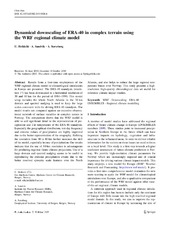Dynamical downscaling of ERA-40 in complex terrain using the WRF regional climate model
Peer reviewed, Journal article
Published version
Permanent lenke
https://hdl.handle.net/1956/4553Utgivelsesdato
2010Metadata
Vis full innførselSamlinger
- Geophysical Institute [1198]
Originalversjon
https://doi.org/10.1007/s00382-010-0928-6Sammendrag
Results from a first-time employment of the WRF regional climate model to climatological simulations in Europe are presented. The ERA-40 reanalysis (resolution 1 ) has been downscaled to a horizontal resolution of 30 and 10 km for the period of 1961–1990. This model setup includes the whole North Atlantic in the 30 km domain and spectral nudging is used to keep the large scales consistent with the driving ERA-40 reanalysis. The model results are compared against an extensive observational network of surface variables in complex terrain in Norway. The comparison shows that the WRF model is able to add significant detail to the representation of precipitation and 2-m temperature of the ERA-40 reanalysis. Especially the geographical distribution, wet day frequency and extreme values of precipitation are highly improved due to the better representation of the orography. Refining the resolution from 30 to 10 km further increases the skill of the model, especially in case of precipitation. Our results indicate that the use of 10-km resolution is advantageous for producing regional future climate projections. Use of a large domain and spectral nudging seems to be useful in reproducing the extreme precipitation events due to the better resolved synoptic scale features over the North Atlantic, and also helps to reduce the large regional temperature biases over Norway. This study presents a highresolution, high-quality climatological data set useful for reference climate impact studies.
Utgiver
SpringerOpphavsrett
The Author(s) 2010Copyright The Author(s) 2010. This article is published with open access at Springerlink.com

